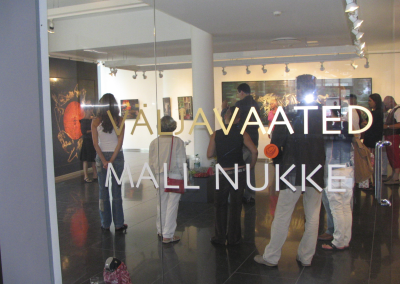„The Prospects“, „The Prospects II“
„The Prospects“ Pärnu’s City Gallery 2006
Artist adds chaos to still life
Art is primarily a game and a fiction, and the artist Mall Nukke, with her new exhibition at Pärnu City Gallery „Prospects” is playing with ideas about the future – what are Estonia’s prospects and what are mankind’s prospects for survival?
Nukke’s pictures are a combination of acrylic paint and digital prints. They look like painting because they have been lacquered. Some of them are oil paintings and some have been gilt. Nukke is well known for her collage technique and that element is also present in these works. The exhibition’s title „Prospects“ (in Estonian literally “views out”) refers to the idea of prospects for the future, but also a view looking out from a window and the view from Estonia onto the rest of the world. This view requires a variety of approaches.
Nukke’s painting “View from the studio onto the city” depicts a room with its everyday bits and pieces, and suggests a comfortable absence. At the same time there is a view between the curtains onto an office building in the city – the city is Tartu. An aeroplane is about fly into the building. The events of 9/11 are repeating. There is always the chance of catastrophe. There is no point thinking we are separate from the world. The skeletons on the next two panels seem to refer to the “Dance of Death”. But Nukke clarifies the point that these are in fact mutated people, to be specific, urban people who have become urban animals. The people have become strange monsters, a kind of machine-person in a shopping frenzy. „Urban people have a mania for going to supermarkets and buying things en-mass. Life revolves around discounts. It is like a sun that provides light and warmth for the urban animal,“ says Nukke.
Silja Joon
Pärnu Postimees, 2006, 04 August
„The Prospects II“ Artdepoo Gallery 2007
The End of the World
Mall Nukke stresses that the idea behind her work is simple, sometimes claiming that she makes a work with a cool head. At times she has been seen to prefer idealists to rationalists. The former try to improve the world while the latter compose more and more equations, the results of which are the end of the world. In this sense Mall Nukke is one of the rationalists since the final resolution of her pictures is also the end of the world.
Mall Nukke’s first simple idea is to place her pictures in the ArtDepoo gallery as in a basilica. The “altar painting” is an upright skinless figure straight out of an anatomy textbook whose pose is nothing if not theatrical since the head and arms must be raised in order to expose the throat and armpits. In one hand it holds the sign for infinity, in the other, the symbol for toxic waste. The background to this image of the birth of Homo Urbanus is a supernova-like explosion. The “nave paintings” depict the creation of man by Michelangelo’s Sixtine God, who with a sweep of the hand puts monkeys in suits and ties. The scalpel in the hand of the surgeon is a tool for creating beauty. Dead hands attached to the connecting rods of a crank mechanism pump a heart. The round “rose window” over the doorway on the end wall depicts money + beauty.
Mall Nukke’s second simple idea is the focal point that characterizes her entire work. Her pictures provide a resting place for the eyes as obviously as chairs do for the weary. The “rose window” and “nave paintings” depict furious whirlpools whose energy concentrates, overheats and explodes with a force multiplied by the number of pictures to become the crash of the “altar painting”.
The third simple idea is sustainable and green. The material used in the pictures is torn out of On-Off catalogues, women’s magazines and all sorts of junk mail that piles up in mailboxes. The viewer can decide for himself how simple it is to tear paper into strips and glue them all over picture surfaces of one-and-a-half to four square metres. The slightly crinkled glued pieces of paper with their rough edges compose dynamic currents just like the overload that rips through the electric chair.
Andri Ksenofontov,
Sirp, 2007, 08 June
















